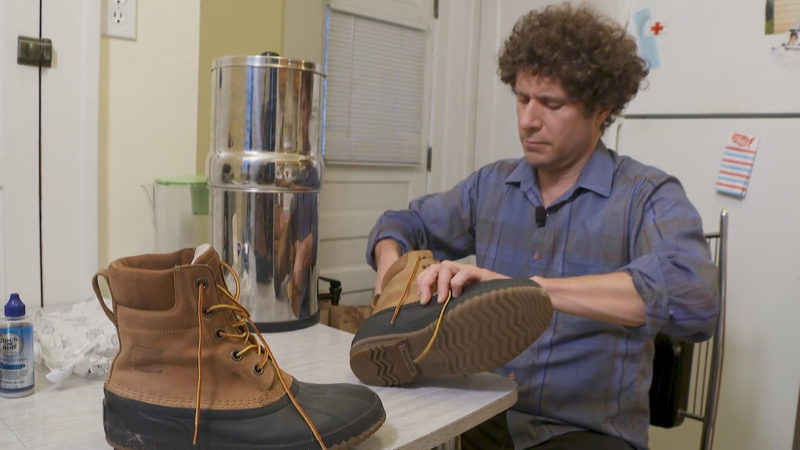After spending several months reporting on the PFAS crisis, I had an alarming realization: taco night might be poisoning me.
I learned that the type of nonstick pans that I used to fry the fish usually contain the toxic chemicals, also called per- and polyfluoroalkyl substances. Research alerted me to their use in some types of parchment paper, which I used to roll tortillas, while the aluminum foil in which I wrapped leftovers raised a red flag with its “nonstick” label. For dessert, I purchased cookies that a local bakery packed in the type of paper bags sometimes treated with PFAS, and the chemicals may have been in my tap water and fish.
But PFAS, dubbed “forever chemicals” because they don’t naturally break down, aren’t only lurking in the kitchen. The synthetic compounds are often used to make thousands of everyday products water, stain and grease resistant, and they’re popular with manufacturers across dozens of industries because they’re so effective. That’s a problem because the class of about 4,700 compounds is linked to serious health problems like cancer, heart disease, birth defects, liver disease and decreased immunity.
The extent of PFAS contamination is only now coming into focus – studies have found drinking water supplies for well over 100 million people across demographic lines may be contaminated by the chemicals. It’s estimated that they’re present in 97% of Americans’ blood, and public health advocates are just starting to understand how widespread their use is in everyday products.
Research has found that PFAS might also be in my dental floss, waterproof boots, umbrella, mattress pad, bike chain lube, cellphone, clothing, camping gear and more. They’re used in a range of personal care products from moisturizer to bar soap to cosmetics by a number of brands. Meanwhile, my couch and carpet may have been treated with Scotchgard or other stain guards that use PFAS to make products stain resistant.

Tom Perkins’ cat, Ling Ling, whose blood contained PFAS chemicals.Image: Great Lakes Now
The more I dug into the chemicals’ myriad uses, the more I found that I’m potentially exposed to them in nearly every facet of daily life in my house.
I soon began to scan my home for products that potentially contained them and anxiously wondered: “Am I being poisoned by a steady drip of PFAS?”
I set out to answer that question by checking dozens of household items, my tap water and blood samples from my cat, Ling Ling, and me for the chemicals. I sent the results to toxicologists and PFAS researchers who provided insight on what they mean and helped answer my question. The testing was performed by two independent laboratories that are among the few nationwide that can conduct such analyses.
Testing confirmed that my and Ling Ling’s blood is contaminated with PFAS. The levels for several compounds are what Graham Peaslee, a University of Notre Dame PFAS researcher, called “unusually high” and at quantities at which toxicologists say they start seeing links to health problems. Some experts who reviewed the results said they believe a case that I am being slowly poisoned could be made, but they also cautioned that PFAS’s presence in my blood doesn’t necessarily mean I’ll ever become sick.
And while testing indicated the chemicals’ use in products throughout my home, it’s unclear how they contributed to my blood’s contamination, and the project often raised more questions than it answered.
The results and uncertainty are, in a word, distressing.
‘They’re coming from so many places’
Labs detected or I was able to confirm the chemicals’ presence in 15 common products, and there are undoubtedly more in items that weren’t checked. State regulators since 2018 have been monitoring drinking water supplies and my tap water test came back clean, but it’s possible that it has been contaminated in the past.
Blood tests revealed four types of PFAS compounds in my and Ling Ling’s blood. They’re among the most common used by industry, and three exceeded the median US blood levels for adult humans. That included PFHxS, which was measured in my blood at 2.7 nanograms per liter, and in Ling Ling’s blood at about 13 nanograms per liter. The US median for humans is about one nanogram per liter.
Though the amount of PFAS in our blood is minuscule, the levels for each compound (except one) are above US medians, and that could present a health threat, said Erika Schreder, a toxicologist with Toxic Free Future. The Seattle-based non-profit studies PFAS contamination and pushes industry to find alternatives to the chemicals.
“Unfortunately, we do see that typical levels can be tied to certain health issues, like reduced immunity, so that is definitely a concern,” Schreder said after reviewing my results.
Just as it’s impossible to know how many cigarettes cause cancer, there’s no clear level of exposure to PFAS that will cause health problems. Ling Ling and I may still be exposed to the chemicals and I worry about what it could mean for us 10 or 20 years down the road. Carla Ng, a University of Pittsburgh researcher who models PFAS’s bioaccumulation in organisms, called the persistent cultural misconception that exposure to chemicals isn’t a problem if it doesn’t immediately harm us “old-fashioned”.
“We’re understanding that a lot of the long-term chronic disease that people have can links back to these cumulative exposures over their lifetime,” Ng added. “It’s not just about keeping somebody from keeling over, it’s about reducing the overall burden of environmentally associated diseases in the US population, which is pretty big.”
While the lab results provide useful information, the chemicals’ nature, and sheer ubiquity, gaps in testing capabilities and industry data make it nearly impossible to get an accurate read of how much PFAS are in our bodies. It’s also difficult to connect the dots between the chemicals in my blood and home with any precision.
“It’s the fact that PFAS are so pervasive,” Ng said. “It’s not just in electronics, healthcare products or consumer products – it’s in all of those things, which makes [the project] nearly impossible because they’re coming from so many places.”
Moreover, PFAS in my household goods today could show up in my water or dinner long after I discard them. The compounds used during the manufacturing process or when products containing PFAS are put in a landfill can eventually migrate to drinking water supplies and the food chain.
That also makes it difficult to draw a clear link between the compounds found in my blood and anything currently in my home, said Courtney Carignan, an environmental epidemiologist with Michigan State University. “There’s the problem of a person’s exposure in their home, and then there’s the problem that [the chemicals were] ever made, and are getting into the environment … then can get into your fish later,” she said.
Industry regularly questions whether any of this is cause for concern. The PFAS and Scotchgard producer 3M acknowledges on its website “possible associations with certain biomarkers or health outcomes in people for PFOA and PFOS”, referring to two older PFAS. However, in a statement, a spokesperson said that the “weight of scientific evidence from decades of research does not show that PFOS or PFOA causes harm in people at current or historical levels”.
Products in my home that contain PFAS
Testing found items that contain PFAS from every room in my house, along with my garage and basement.
Most items were checked twice – once by Galbraith Laboratory, a Knoxville lab that’s considered a leader in toxic chemical testing, and by Notre Dame’s Peaslee, a professor of experimental nuclear physics, chemistry and biochemistry. The tests confirmed the presence of fluorine, which indicates PFAS, in my bike chain lube, several types of food packaging, a small mat treated with Scotchgard, waterproof boots, cookware and Oral B Glide dental floss.
The PFAS in these products can take several routes into my body, and may partly explain the elevated blood levels.
PFAS applied to products like a carpet, couch or waterproof clothing continually break off and are breathed in, or attach to dust that gets on our hands and is ingested. The chemicals can then accumulate in our organs and could trigger disease.
Toxic Free Future’s Schreder said she visualizes the protective stain-resistant layer that PFAS form as a shag carpet. The pieces of shag repel water and stains, but, over time, the shag breaks off. “They can go up into the air, so then they’re contaminating your indoor air in your home and you breathe them in,” she said. “Then you convert them in your body into these highly persistent compounds.”
Studies have found pets like Ling Ling often have higher levels of PFAS in their blood than humans, partly because they’re smaller, and partly because “if you’re a toddler or a cat, then you spend a lot more time kind of interacting with house dust,” Schreder said. Indeed, Ling Ling had higher levels of two compounds than I did.

Perkins swabs his shoes so samples can be tested for PFAS.Image: Great Lakes Now
In my house, my waterproof Sorel boots and the small mat in my basement that had been treated with Scotchgard put me at potential risk for this type of exposure. Researchers told me furniture, carpets and shoes treated with stain protectors like Scotchgard are a prevalent source of PFOS contamination in my house and Americans’ blood, and that PFAS compound was found in my blood. Sorel didn’t respond to requests for comment.
By some estimates, up to 90% of carpets on the market were treated with PFAS products until the industry shifted away from them last year. That followed proposals to ban PFAS-treated carpets in several states and decisions by retailers like Home Depot and Lowe’s to stop selling Scotchgard-treated carpets. The PFAS have been replaced by stain guards free of the chemicals.
Though Notre Dame’s Peaslee didn’t detect PFAS in my couch or a carpeted room, the chemicals can stay in our bodies for decades. Exposure to pieces of furniture that I owned before my current couch, which I bought two years ago, could be behind some of the PFAS levels in my and Ling Ling’s blood, Schreder said.
Several experts who reviewed my tests were alarmed by the bike lube’s levels, which were the highest of any product in the house. I get the liquid on my hands during my monthly chain lubing, and “that is the kind of product that can lead to a lot of exposure”, Schreder said.
In the kitchen, we confirmed that the parchment paper and nonstick pan used on taco night contained PFAS. We also found the chemicals in carryout packaging from several Detroit restaurants.
The chemicals’ use in food packaging is widespread. Some restaurants probably use at least some packaging that contains them, and some restaurateurs probably aren’t aware. Molded fiber products, for example, categorically contained the chemicals until last year. When I spoke with Avalon International Breads about their cookie bags, Jackie Victor, a co-owner, said she was “shocked” to learn that they contained the chemicals, planned to immediately pull them, and would find an alternative that is PFAS-free. “We’re victims, too,” Victor told me.
Research shows that PFAS in food packaging can leach into food, and that increases with temperature, duration of contact and other factors, said Laurel Schaider, a PFAS researcher with the Silent Spring Institute. The non-profit studies the chemicals’ use in the food industry and in 2017 found PFAS in nearly 50% of fast food wrappers that it tested. The chemicals it identified included PFHxS and PFOA, which were found in my blood.
Silent Spring later analyzed federal PFAS data and found a significant correlation between people who eat out and higher levels of the chemicals in their blood. “What we ate yesterday can stay in our bodies for years,” Schaider said.
PFAS in our blood
Are the PFAS that are in my home responsible for the PFAS in my blood? Experts with whom I spoke say almost certainly, but this is where the picture gets especially fuzzy.
The California-based Vista Analytical Laboratory checked my and Ling Ling’s blood for 24 compounds. In both of us it detected elevated levels of PFOA. The compound was commonly used to produce PTFE that was applied to a wide range of consumer products, including the pan I used to fry the fish, bike lube, plumber’s tape and dental floss.
In Ling Ling and me, the test found PFOS and PFHxS, which are constituents of firefighting foam, and the former was in Scotchgard until 2003. My blood also contains PFNA, which is used in the production of nonstick and stain-resistant coatings.

Food packaging was among the items Tom Perkins had tested for PFAS.Image: Great Lakes Now
A tool developed by Carignan and Silent Spring shows how my and Ling Ling’s levels compare with those of adult humans living in the US.
While some of the chemicals are probably present in products in my home, Galbraith’s test tells us how much fluorine is in the items, but doesn’t identify individual PFAS compounds.
Experts with whom I spoke said it was also possible that the chemicals are in our food, especially fish, which Ling Ling and I regularly eat. PFAS are also turning up in livestock and crops via pesticides, contaminated sewage sludge used as fertilizer, and contaminated water used on farms.
In the US, industry is replacing the older, longer compounds with a newer generation of PFAS that it claims are safer, though that claim is contradicted by a growing body of research. Testing didn’t find those chemicals in my blood, but that doesn’t mean they aren’t in Ling Ling and me.
Ng said commercial labs didn’t have the ability or analytical standards to check our blood for more than about 40 PFAS compounds, but thousands exist.
This unknown adds extra layers of anxiety and leaves me wondering if I should run to my doctor for a cancer screening or liver check. It’s possible the chemicals are behind my high cholesterol, though the cookies and milkshakes that are part of my weekly diet could be driving it.
Most companies that I contacted for comment didn’t respond. Procter and Gamble, which uses PTFE in its Oral B Glide dental floss, stated that Oral B tested negative for the presence of PFAS, and claimed PTFE isn’t PFAS. Chemical companies have recently begun making that claim, and argue that it’s safer because it does not necessarily accumulate in the body in the same way as other such compounds.
But experts who spoke with me say there isn’t enough independent science to determine whether PTFE is safe or not. PTFE has also generally been considered a PFAS compound, and the EPA classifies it as such. Moreover, Ng noted that other PFAS compounds are used in PTFE production, which she said is a concern.
Procter and Gamble also said in the statement that it tested its floss using a modified version of the EPA 537 method. This test, however, doesn’t check for PTFE, or most of the 4,700 PFAS compounds. By contrast, our tests looked for the total level of fluorine, which is the common element in all PFAS, and gives labs a clearer idea of how much PFAS might be in a product. Our test showed that fluorine composes 17% of Oral-B Glide floss.
Concerned, Graham Peaslee told me he has switched to waxed floss.
Trying to identify the chemicals’ sources is a bit maddening and stressful. It’s simply not clear how much the PFAS in each item is contributing to the levels in our blood. “You worry because these are in your blood, and they may have been in your blood for a long time, so it’s hard to know if a health condition that develops is caused by PFAS exposure, but that will be in the back of your mind,” Ng she said. “It’s fundamentally unfair that we have to deal with this for the convenience of not having eggs stick to the pan.”
This story was produced by Type Investigations in partnership with Great Lakes Now/Detroit Public TV, Consumer Reports and The Guardian.

Tom Perkins is a freelance reporter in Hamtramck, Mich., who writes about the environment, food, and politics.